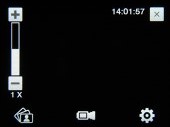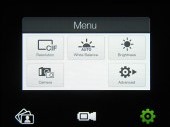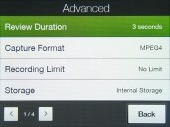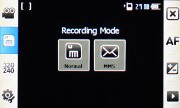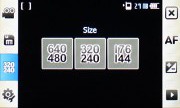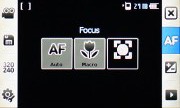HTC Touch Diamond vs. Samsung i900 Omnia: Head-to-Head
Head-to-Head
Cameras are obviously no match for each other
You can already guess that the Diamond's 3 megapixel shooter is no match for the Omnia's 5 megapixel camera. Now think about it this way - image resolution and resolved detail are only part of image quality. So we guess we can take a more unbiased approach and compare the other ingredients of a good camera recipe.
Both devices offer intuitive user interface and shoot in landscape mode. The Diamond lacks a dedicated camera key, while the Omnia has one. In order to focus before you snap a picture with the Diamond, you simply touch the touch-sensitive D-pad. Once focus is locked, you can take the picture by pressing the confirm button of the D-pad.
The Samsung Omnia camera is equipped with a LED flash, while the Diamond doesn't have one at all. Our team is hardly fond of LED flashes, so we don't count this as a serious flaw of the Diamond.
Interface and usability
The Diamond viewfinder is free of any overlaying controls, but since the Omnia display has a different aspect ratio than the one of its camera sensor, it easily fits two columns of controls on the left and right side of the viewfinder.



Shooting with the HTC Touch Diamond and the Samsung i900 Omnia
The Omnia camera offers several shooting modes (single, continuous, mosaic, panorama and the smile detection one). The smile detection mode makes use of face recognition and in this mode the camera doesn't take a photo immediately as you press the shutter all the way down. Instead, it waits for the smiles on all recognized faces in the frame.
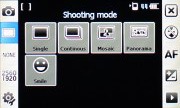
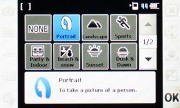
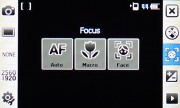
Samsung i900 Omnia camera interface
The Omnia also offers extensive shoot scenes (portrait, landscape, sports, party & indoor, beach & snow, sunset, dusk & down, fall color, night shot, fireworks, text, show window, candle light, back light).
You can also directly control the auto focus (regular, macro and face detection) from an icon on the viewfinder.
The additional camera settings include self-timer, white balance, color effect, ISO setup (ISO50-800), on-screen gridline and shutter sound (which unfortunately cannot be turned off).
And finally, the Omnia offers the proprietary Samsung Wide Dynamic Range setting (not really that useful), as well as GPS geotagging.
So overall, you get all the goodies of a high-end cameraphone plus even more. We'll cover image quality in a second.
The HTC Touch Diamond camera is regularly equipped and offers the standard self-timer, white balance presets, as well as color effects, and a viewfinder gridline. You can shoot images with the front-facing video-call camera too and there's some nice custom resolution setting for contacts' images.

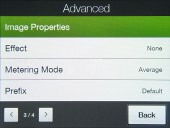
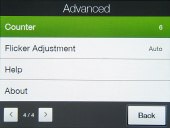
The HTC Touch Diamond camera interface
Probably the biggest letdown when it comes to features, is that the camera lacks geotagging. Why that's left out remains beyond us.
With the Touch Diamond you can shoot macro images easily without changing modes or anything. There is also a panorama mode that offers on-screen framing guidance. After all the shots are taken, the Diamond stitches the images automatically. The downside here is that in Panorama mode each individual image is shot at roughly 480 x 480 pixels. Plus, images are badly stitched. Obviously the Panorama mode is only ok if you intend to show your images on the handset display only (which is exactly 480 pixels wide) with no further zooming.
The Samsung Omnia Panorama mode was not that of a treat either. It's still much easier to shoot panoramic images with, as it's fully automatic - it guides you along the horizontal axis and takes images by itself when your framing is good enough. However the individual images are taken in the meager resolution of 320 x 192 pixels. The produced panoramic image is so low in resolution that you can't even check the quality of the stitching job, let alone enjoy some detail in the shot.
The Omnia panoramic mode allows making panoramas out of up to eight consequent shots. Usually the 8-shot images have too wide a field of view and all straight lines in the center distort heavily as if taken by a bad fish-eye lens. Panoramas tend to look much more natural when they comprise out of three or five frames - the geometric distortion is less pronounced.
Let's jump to image quality now and see how both devices fare.
Image quality
There is one great construction fault of the HTC Touch Diamond camera, which makes all produced images mediocre. It may sound surprising but it's the little plastic lens cover that comes as a part of the gem-shaped back panel. It stands right in front of the camera lens and even when perfectly cleaned, it reduces both the contrast and the resolved detail of all photos and especially those of backlit subjects. It's the same fault the iPhone suffers from but, luckily, here we can remove the back cover and do some comparative shots.
With the back cover on, the Diamond camera produces images which are well bellow the average level for a 3 megapixel camera on a mobile phone. The only good thing we can say about it is that it at least lacks the strange textured patterns exhibited by the Touch Cruise and TyTN II cameras that appeared all over uniformly colored areas.
With the back cover removed, the Touch Diamond photos take another shape. Contrast and the resolved detail increase noticeably and images turn out almost higher than average.
Shot with the cover on:



Shot with the cover off:



The Samsung i910 Omnia is another matter entirely. It produces crisp and tack sharp images with balanced processing and accurate colors. The Omnia is probably the first PocketPC that we've seen to produce impressive camera samples.
Video
The Touch Diamond video capturing capabilities are not impressive at all. All you get is CIF recording (352 x 288 pixel) at 30fps. It's not that bad: after all the VideoCD standard uses that resolution, but it's nowhere near what you would expect from a high-end smart device.
The interface of the camcorder resembles the one of the still camera. You can only adjust the white balance, the resolution and brightness and finally add some color effects.
The Omnia on the other hand can shoot VGA video (640 x 480 pixels) at 15fps or QVGA video (320 x 240 pixel) at 30fps. Honestly, we are not really sure which device will be less of a compromise if video is important to you. If you don't mind the lower frame rate the Omnia offers much more resolution. If the frame rate is important to you, then the Diamond gets the winning points.
Here are the sample videos produced by the Touch Diamond and the Samsung i900 Omnia. The Touch Diamond video is MPEG4 CIF@30fps. The first Omnia video is shot in MPEG4 VGA@15fps, while the second Omnia video is recorded in MPEG4 QVGA@30fps.
Reader comments
- Anonymous
- 27 May 2012
- fmg
how do u i change samsung omnia i900 language
- Anonymous
- 28 Jun 2011
- fjQ
I say omnia is gud dan htc,t got 8 GB on bord and 8GB memory card so t hv more futures,5MB camera,windows phne!agg omnia iz beter guyz!
- AnonD-3162
- 06 Mar 2011
- tYR
Whose Better(????) lets compare!! 1 Hardware (Omnia) processor,camera,in/ex memory,battery 2 Tecnology (Omnia) TFT technology 3 Performance (Omnia) Equal whit spec 4 Best Price 2nd (Omnia) HTC IDR 1.350.000, Omnia IDR 1.65...


